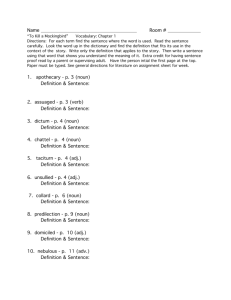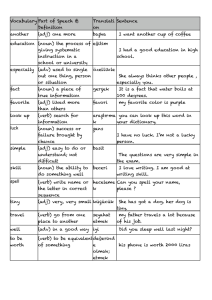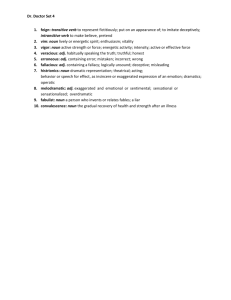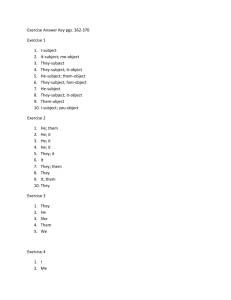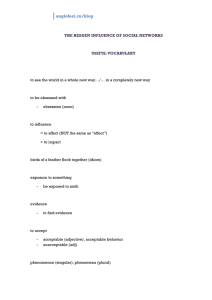Intelligent Information Retrieval and Web Search
advertisement
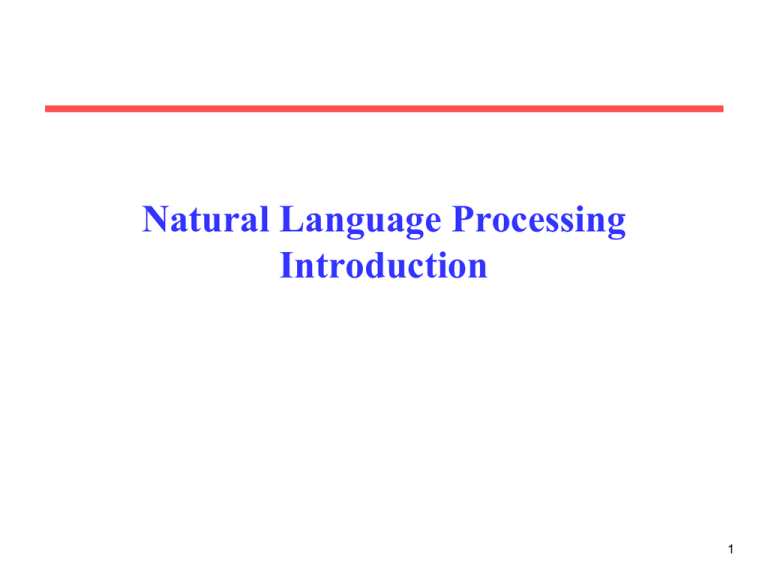
Natural Language Processing
Introduction
1
Course materials and
Acknowledgements
• Book: SPEECH and
LANGUAGE
PROCESSING
• Other links:
– http://www.cs.utexas.edu/~mo
oney/cs388/
– http://www.cs.colorado.edu/~
martin/slp2.html
– http://www.stanford.edu/class/
cs224s/
• Course material on:
http://twiki.di.uniroma1.it/twiki
/view/NLP/WebHome
Natural Language Processing
• “NLP is the branch of computer science
focused on developing systems that allow
computers to communicate with people
using everyday language” (R. Mooney).
• Also called Computational Linguistics
– Also concerns how computational methods can
aid the understanding of human language
NLP is about COMMUNICATION
3
Course syllabus
• Introduction to NLP (today)
• Machine learning methods for NLP
(Prof. R. Basili)
• Information Retrieval and Extraction
• Question Answering
• Dialogue systems
4
Related Areas
•
•
•
•
•
•
•
Artificial Intelligence
Formal Language (Automata) Theory
Machine Learning
Linguistics
Psycholinguistics
Cognitive Science
Philosophy of Language
5
Why NLP in your curriculum?
• Huge amounts of data
– Internet = at least 20
billions pages
– Intranet
• Applications for
processing large
amounts of texts
require NLP expertise
•
•
•
•
Classify text into categories
Index and search large texts
Automatic translation
Speech understanding
– Understand phone conversations
• Information extraction
– Extract useful information from
resumes
• Automatic summarization
– Condense 1 book into 1 page
• Question answering
• Knowledge acquisition
• Text generations / dialogues
Why NLP in your curriculum ?
• Yahoo, Google, Microsoft Information Retrieval
• Monster.com, HotJobs.com (Job finders)
Information Extraction + Information Retrieval
• Systran powers, Babelfish, Google Translate
Machine Translation
• Ask Jeeves,Wiki.answers Question Answering
• Myspace, Facebook, Blogspot Processing of UserGenerated Content
• Alice, Eliza Conversational agents
• Tools for “business intelligence”
• All “Big Guys” have (several) strong NLP research
labs:
– IBM, Microsoft, AT&T, Xerox, Sun, etc.
• Academia: research in an university environment
7
NLP is difficult: Turing Test
• A test of a machine’s ability to demonstrate
intelligence
• Introduced in 1950 by Alan Turing
• "I propose to consider the question, 'Can machines
think?'" Since "thinking" is difficult to define, Turing
chooses to "replace the question by another, which is
closely related to it and is expressed in relatively
unambiguous words. […] Are there imaginable digital
computers which would do well in the imitation
game?"
– Alan Turing, “Computing Machinery and
Intelligence” (1950)
• Inspired by a party game, known as the “imitation
game" (a man vs. a woman). It is a conversational
8
Loebner Prize Gold Medal
• $100,000 and a Gold Medal for the first
computer whose responses were
indistinguishable from a human's
• http://www.loebner.net/Prizef/loebnerprize.html
9
Loebner Prize Gold Medal
• A test of a machine’s ability to demonstrate intelligence
Human judge
Human Player
Computer Player
10
Loebner Prize Gold Medal
• A human judge engages in a (written) natural
language conversation with one human and
one machine
• The players try to appear human (not easy!
Read “ The most human human” by Brian
Christian)
• All participants are separated from each
another
• The judge tries to determine which player is a
computer and which is a human
• Assumption: NLP is AI-complete!
11
Loebner Prize Gold Medal
• Winner is the program that manages to
convince humans that he is a human
• No one so far fully convinced all the
judges, but the winner is the one that
gets closer
• In 2008 a program missed the target by
one vote only!
• But they use (also) tricks..and
psychology.
12
“Eccentric” answers
• By often changing the topic of
conversation and saying funny things a
computer can give the impression of a
“human” personality
• Judge: Today I had hard time. I would
like to relax a bit now. Do you have any
joke to chase away the clouds??
• Computer:everyone talks about time,
but no one does anything about. Why
did you feel as saying ME that you
13
The first conversational “computer”
• Hal 9000
14
Science fiction..
….But in 2011…
15
IBM Watson QA computer
• On february 2011 winned the Jeopardy!
contest against two humans
• Operating on a single CPU, it could take
Watson two hours to answer a single
question. A typical Jeopardy! contestant can
accomplish this in less than three seconds.
• For Watson to rival the speed of its human
competitors in delivering a single, precise
answer to a question requires custom
algorithms, terabytes of storage and
thousands of POWER7 computing cores
working in a massively parallel system.
16
Example
• “A recent best seller by Muriel Barbery
is called ‘This of the Hedgehog,’ ”
• Watson “What is Elegance?”
• “You just need a nap. You don’t have
this sleep disorder that can make
sufferers nod off while standing up,”
• Watson “What is narcolepsy?”
17
Algorithms+Brute Force computing
power
• The team fed numerous databases of
knowledge into Watson's 16-terabyte
memory, including multiple dictionaries,
thesauri and even the entire text of
Wikipedia, then armed it with the best
available NLP algorithms to determine
the correct response.
18
Brute force, but not so much..
• Watson's main innovation was not in the
creation of a new algorithm but rather its
ability to quickly execute thousands of
language analysis algorithms simultaneously
to find the correct answer.
• The more algorithms that find the same
answer independently the more likely Watson
is to be correct.
• Once Watson has a small number of
potential solutions it is able to check against
its database to ascertain if the solution makes
sense.
19
So what about this course?
•
•
•
•
To understand what the problems are
To study (some) available solution
Solution=algorithm
So algorithms, after all!
20
..as any other field of computer
science, NLP:
• Need to decompose the problem into
sub-problems
• Find a reasonable solution for subproblems
• Implement solution with an algorithm
21
Sub-problems of NLP
22
NLP= Communication
• The goal in the production and comprehension of
natural language is communication.
• Communication for the speaker:
– Intention: Decide when and what
information should be transmitted (a.k.a. strategic
generation). May require planning and reasoning
about agents’ goals and beliefs.
– Generation: Translate the information to be
communicated (in internal logical representation or
“language of thought”) into string of words in desired
natural language (a.k.a. tactical generation).
– Synthesis: Output the string in desired modality, text
or speech.
23
NLP=Communication (cont)
• Communication for the hearer:
– Perception: Map input modality to a string of words,
e.g. optical character recognition (OCR) or speech
recognition.
– Analysis: Determine the information content of the
string.
• Syntactic interpretation (parsing): Find the correct parse tree
showing the phrase structure of the string.
• Semantic Interpretation: Extract the (literal) meaning of the
string (logical form).
• Pragmatic Interpretation: Consider effect of the overall
context on altering the literal meaning of a sentence.
– Incorporation: Decide whether or not to believe the
content of the string and add it to the KB.
24
Doesn’t always works….
Computers are no better than your dog.. But we can
teach them “how-to” by coding our knowledge of the
language comprehension process
25
Aspects of NL processing
• Analysis
• From a natural language text to an
unamiguous and formal (=computer
processable) representation
26
Aspects of NL processing
• Synthesis
• Building programs able to generate a
“correct” natural language text starting from
some formal (=computer processable)
content
Weather
Forecast
generation
from
database
records
Architecture of a NLP system
INPUT
TEXT
SPEECH
Phoneme recognition
Character recognition
Morphological analysis
LEXICAL ANALYSIS
Part-of-speech tagging
Syntactic analysis
Semantic analysis
Pragmatics (discourse analysis)
28
Syntax, Semantic, Pragmatics
• Syntax concerns the proper
ordering of words and its
affect on meaning.
– The dog bit the boy.
– The boy bit the dog.
– * Bit boy dog the the.
– Colorless green ideas sleep
furiously.
Syntax, Semantics, Pragmatics
• Semantics concerns the (literal) meaning of words,
phrases, and sentences.
– “plant” as a photosynthetic organism
– “plant” as a manufacturing facility
– “plant” as the act of sowing
30
Syntax, Semantic, Pragmatics
• Pragmatics concerns the overall communicative
and social context and its effect on interpretation.
– I went on holidays. It was my best time this
year. (co-reference, ἀναφορά, "carrying back")
– “the best course of action ... is doing nothing at
all.”. (ἔλλειψις, ellipsis, "omission")
31
Ambiguity is the main issue in all NLP
phases
• Natural language is highly
ambiguous and must be
disambiguated.
– I saw the man on the hill with a
telescope.
– I saw the Grand Canyon flying to
LA.
32
Ambiguity is Ubiquitous
• Speech Recognition
– “recognize speech” vs. “wreck a nice beach”
– “youth in Asia” vs. “euthanasia”
• Morphology/POS
– Fly (noun, verb)
• Syntactic Analysis
– “I ate spaghetti with chopsticks” vs. “I ate spaghetti with meatballs.”
• Semantic Analysis
– “The lion is in the pen.” vs. “The ink is in the pen.”
– “I put the plant in the window” vs. “Ford put the plant in Mexico”
• Pragmatic Analysis
– From “The Pink Panther Strikes Again”:
– Clouseau: Does your dog bite?
Hotel Clerk: No.
Clouseau: [bowing down to pet the dog] Nice doggie.
[Dog barks and bites Clouseau in the hand]
Clouseau: I thought you said your dog did not bite!
Hotel Clerk: That is not my dog.
33
Ambiguity is Explosive
• Ambiguities generate an enormous numbers of
possible interpretations.
• In English, a sentence ending in n
prepositional phrases has over 2n syntactic
interpretations (cf. Catalan numbers).
– “I saw the man with the telescope”: 2 parses
– “I saw the man on the hill with the telescope.”: 5 parses
– “I saw the man on the hill in Texas with the telescope”:
14 parses
– “I saw the man on the hill in Texas with the telescope at
noon.”: 42 parses
– “I saw the man on the hill in Texas with the telescope at
noon on Monday” 132 parses
34
Why is Language Ambiguous?
• Having a unique linguistic expression for every
possible conceptualization that could be conveyed
would making language overly complex and
linguistic expressions unnecessarily long.
• Allowing resolvable ambiguity permits shorter
linguistic expressions, i.e. data compression.
• Language relies on people’s ability to use their
knowledge and inference abilities to properly
resolve ambiguities.
• Infrequently, disambiguation fails, i.e. the
compression is lossy
35
Time flies like an arrow
36
Natural Languages vs. Computer Languages
• Ambiguity is the primary difference between
natural and computer languages.
• Formal programming languages are designed to be
unambiguous, i.e. they can be defined by a
grammar that produces a unique parse for each
sentence in the language.
• Programming languages are also designed for
efficient (deterministic) parsing, i.e. they are
deterministic context-free languages (DCFLs).
– A sentence in a DCFL can be parsed in O(n) time
where n is the length of the string.
37
Natural Language Tasks
• Processing natural language text involves
various syntactic, semantic and pragmatic
tasks in addition to other problems.
38
Lexical and Syntactic Tasks
Word Segmentation
• Breaking a string of characters (graphemes) into a
sequence of words.
• In some written languages (e.g. Chinese) words
are not separated by spaces.
• Even in English, characters other than white-space
can be used to separate words [e.g. , ; . - : ( ) ]
• Examples from English URLs:
– jumptheshark.com jump the shark .com
– myspace.com/pluckerswingbar
myspace .com pluckers wing bar
myspace .com plucker swing bar
Morphological Analysis
• Morphology is the field of linguistics that studies the
internal structure of words. (Wikipedia)
• A morpheme is the smallest linguistic unit that has
semantic meaning (Wikipedia)
– e.g. “carry”, “pre”, “ed”, “ly”, “s”
• Morphological analysis is the task of segmenting a word
into its morphemes:
– carried carry + ed (past tense)
– independently in + (depend + ent) + ly
– Googlers (Google + er) + s (plural)
– unlockable un + (lock + able) ?
(un + lock) + able ?
Part Of Speech (POS) Tagging
• Annotate each word in a sentence with a
part-of-speech.
I ate the spaghetti with meatballs.
Pro V Det
N
Prep
N
John saw the saw and decided to take it to the table.
PN V Det N Con V Part V Pro Prep Det N
• Useful for subsequent syntactic parsing and
word sense disambiguation.
Phrase Chunking
• Find all non-recursive noun phrases (NPs)
and verb phrases (VPs) in a sentence.
– [NP I] [VP ate] [NP the spaghetti] [PP with]
[NP meatballs].
– [NP He ] [VP reckons ] [NP the current account
deficit ] [VP will narrow ] [PP to ] [NP only #
1.8 billion ] [PP in ] [NP September ]
Syntactic Parsing
• Produce the correct syntactic parse tree for a
sentence.
Semantic Tasks
Word Sense Disambiguation (WSD)
• Words in natural language usually have a
fair number of different possible meanings.
– Ellen has a strong interest in computational
linguistics.
– Ellen pays a large amount of interest on her
credit card.
• For many tasks (question answering,
translation), the proper sense of each
ambiguous word in a sentence must be
determined.
46
Semantic Role Labeling (SRL)
• For each clause, determine the semantic role
played by each noun phrase that is an
argument to the verb.
agent patient source destination instrument
– John drove Mary from Austin to Dallas in his
Toyota Prius.
– The hammer broke the window.
• Also referred to a “case role analysis,”
“thematic analysis,” and “shallow semantic
parsing”
47
Semantic Parsing
• A semantic parser maps a natural-language
sentence to a complete, detailed semantic
representation (logical form).
• For many applications, the desired output is
immediately executable by another program.
• Example: Mapping an English database query to a
logic expression:
How many cities are there in the US?
answer(A, count(B, (city(B), loc(B, C),
const(C, countryid(USA))),
A))
48
Textual Entailment
• Determine whether one natural language
sentence entails (implies) another under an
ordinary interpretation.
Textual Entailment Problems
from PASCAL Challenge
TEXT
Eyeing the huge market potential, currently
led by Google, Yahoo took over search
company Overture Services Inc last year.
HYPOTHESIS
Yahoo bought Overture.
Microsoft's rival Sun Microsystems Inc.
bought Star Office last month and plans to
boost its development as a Web-based
Microsoft bought Star Office.
device running over the Net on personal
computers and Internet appliances.
ENTAIL
MENT
TRUE
FALSE
The National Institute for Psychobiology in
Israel was established in May 1971 as the
Israel Center for Psychobiology by Prof.
Joel.
Israel was established in May
1971.
FALSE
Since its formation in 1948, Israel fought
many wars with neighboring Arab
countries.
Israel was established in
1948.
TRUE
Pragmatics/Discourse Tasks
Anaphora Resolution/
Co-Reference
• Determine which phrases in a document refer
to the same underlying entity.
– John put the carrot on the plate and ate it.
– Bush started the war in Iraq. But the president
needed the consent of Congress.
• Some cases require difficult reasoning.
• Today was Jack's birthday. Penny and Janet went to the store.
They were going to get presents. Janet decided to get a kite.
"Don't do that," said Penny. "Jack has a kite. He will make you
take it back."
Ellipsis Resolution
• Frequently words and phrases are omitted
from sentences when they can be inferred
from context.
"Wise men talk because they have something to say;
fools, because they have to say something.“ (Plato)
"Wise men talk because they have something to say;
fools talk because they have to say something.“ (Plato)
Putting all tasks together
54
Pipelining Problem
• Assuming separate independent components for
speech recognition, syntax, semantics, pragmatics,
etc. allows for more convenient modular software
development.
• However, frequently constraints from “higher
level” processes are needed to disambiguate
“lower level” processes.
– Example of syntactic disambiguation relying on
semantic disambiguation:
• At the zoo, several men were showing a group of students
various types of flying animals. Suddenly, one of the students
hit the man with a bat.
55
Pipelining Problem (cont.)
• If a hard decision is made at each stage, cannot
backtrack when a later stage indicates it is
incorrect.
– If attach “with a bat” to the verb “hit” during syntactic
analysis, then cannot reattach it to “man” after “bat” is
disambiguated during later semantic or pragmatic
processing.
56
Increasing Module Bandwidth
• If each component produces multiple scored
interpretations, then later components can rerank
these interpretations.
Acoustic/
Phonetic
sound
waves
Syntax
words
Semantics
parse
trees
Pragmatics
literal
meanings
meaning
(contextualized)
• Problem: Number of interpretations grows
combinatorially.
• Solution: Efficiently encode combinations of
interpretations.
• Word lattices
• Compact parse forests
57
Global Integration/
Joint Inference
• Integrated interpretation that combines
phonetic/syntactic/semantic/pragmatic
constraints.
Integrated
Interpretation
sound
waves
meaning
(contextualized)
• Difficult to design and implement.
• Potentially computationally complex.
58
So far we listed only problems..
• Forthcoming lessons will show solutions
for specific applications (Information
Extraction, Question Answeing..)
• Now: An example of (not so “specific”)
solution for the problem of POS tagging
59
An example: POS tagging algorithms
• Several algorithms for POS tagging
have been defined in literature, based
on algebraic, probabilistic or knowledge
based methods
• Today: Hidden Markov Models and the
Viterbi algorithm
• Why: a widely use algorithm for a
variety of applications (cellular phones,
human genoma, and more)
60
Summary of HMM
• Hidden Markov Models are a stocastic
modely widely used in computer science,
especially in telecommunications
• In NLP, HMM are used for:
– Speech recognition
– Part of Speech tagging
– Syntactic analysis
Markov Models
of states: {s1 , s2 , , s N }
• Process moves from one state to another generating a sequence of states :
• Set
si1 , si 2 , , sik ,
(kth state of sequence i)
• Markov chain property: probability of each subsequent state depends only
on the previous state:
P( sik | si1 , si 2 , , sik 1 ) P( sik | sik 1 )
• To define a Markov model, the following probabilities have to be specified:
transition probabilities a P( s | s ) and initial probabilities P ( s )
i
i
ij
i
j
Example of Markov Model
0.3
0.7
Rain
Dry
0.2
0.8
• Two states : ‘Rain’ and ‘Dry’.
• Transition probabilities: P(‘Rain’|‘Rain’)=0.3 , P(‘Dry’|‘Rain’)=0.7 ,
•P(‘Rain’|‘Dry’)=0.2, P(‘Dry’|‘Dry’)=0.8
• Initial probabilities: P(‘Rain’)=0.4 , P(‘Dry’)=0.6 .
Calculation of sequence probability
• By Markov chain property, the probability of a state sequence
can be found by the formula:
P( si1 , si 2 , , sik ) P( sik | si1 , si 2 , , sik 1 ) P( si1 , si 2 , , sik 1 )
P( sik | sik 1 ) P( si1 , si 2 , , sik 1 )
P( sik | sik 1 ) P( sik 1 | sik 2 ) P( si 2 | si1 ) P( si1 )
• Suppose we want to calculate a probability of a sequence of
states in our example, {‘Dry’,’Dry’,’Rain’,Rain’}.
P({‘Dry’,’Dry’,’Rain’,Rain’} ) =
P(‘Rain’|’Rain’) P(‘Rain’|’Dry’) P(‘Dry’|’Dry’) P(‘Dry’)=
= 0.3*0.2*0.8*0.6
Hidden Markov models.
• Set of states:{s1 , s2 , , s N }
•Process moves from one state to another generating a
si1 , si 2 , , sik ,
sequence of states :
• Markov chain property: probability of each subsequent state
depends only on what was the previous state:
P( sik | si1 , si 2 , , sik 1 ) P( sik | sik 1 )
• States are not visible, but each state randomly generates one of
M observations (or visible output)
{v1 , v2 , , vM }
• To define hidden Markov model, the following probabilities
have to be specified: matrix of transition probabilities A=(aij),
aij= P(si | sj) , matrix of observation probabilities B=(bmi)=
P(vm | si) and a vector of initial probabilities =(i), i = P(si) .
Model is represented by M=(A, B, ).
Example of Hidden Markov Model
0.3
0.7
Low
High
0.2
0.6
Rain
0.4
0.8
0.6
0.4
Dry
Weather conditions are VISIBLE, the states are HIDDEN (Low or High Pressu
Example of Hidden Markov Model
• Two
states : ‘Low’ and ‘High’ atmospheric pressure.
• Two observations : ‘Rain’ and ‘Dry’.
• Transition probabilities: P(‘Low’|‘Low’)=0.3 ,
P(‘High’|‘Low’)=0.7 , P(‘Low’|‘High’)=0.2, P(‘High’|‘High’)=0.8
• Observation probabilities : P(‘Rain’|‘Low’)=0.6 (“probability of
seeing rain when the pressure is low”), P(‘Dry’|‘Low’)=0.4 ,
P(‘Rain’|‘High’)=0.4 , P(‘Dry’|‘High’)=0.3 .
• Initial probabilities: P(‘Low’)=0.4 , P(‘High’)=0.6 .
Calculation of observation sequence
probability
• Suppose we want to calculate a probability of a sequence of
observations in our example, {‘Dry’,’Rain’}.
• Consider all possible hidden state sequences:
P({‘Dry’,’Rain’} ) = P({‘Dry’,’Rain’} & {‘Low’,’Low’}) +
P({‘Dry’,’Rain’} & {‘Low’,’High’}) + P({‘Dry’,’Rain’} &
{‘High’,’Low’}) + P({‘Dry’,’Rain’} &{‘High’,’High’})
(a visible sequence can be generated by any of the possible
hidden state sequences)
•Joint probabilities are calculated in the following way:
P({‘Dry’,’Rain’} & {‘Low’,’Low’})=
P({‘Dry’,’Rain’} | {‘Low’,’Low’}) P({‘Low’,’Low’}) =
P(‘Dry’|’Low’)P(‘Rain’|’Low’) P(‘Low’)P(‘Low’|’Low)
= 0.4*0.4*0.6*0.4*0.3
Main issues using HMMs :
Evaluation problem. Given the HMM M=(A, B, π) and the
observation sequence O=o1 o2 ... oK , calculate the probability that
model M has generated sequence O .
• Decoding problem. Given the HMM M=(A, B, π) and the
observation sequence O=o1 o2 ... oK , calculate the most likely
sequence of hidden states si that produced this observation
sequence O.
• Learning problem. Given some training observation sequences
O=o1 o2 ... oK and general structure of HMM (numbers of hidden and
visible states), determine HMM parameters M=(A, B, π) that best fit
training data.
O=o1...oK denotes a sequence of observations ok{v1,…,vM}.
POS tagging is an example of
S: part of speech tags
decoding problem
Y: words in a given language
Outside pets are often hit by cars
VERB
PREP
NOUN
ADJ
ADV
The Markov model is not visible. But we assume to know that 1)each state
generate a subset of all possible words; 2)from a given state, certain state
transitions have zero probability (e.g. from PREP to PREP)
Which state sequence is the most
likely ?
• Which state sequence more likely generated
“Outside pets are often hit by cars”?
– Adj Noun Verb Adv Verb Prep Noun
– Adv Noun Verb Adv Verb Prep Noun
– Prep Noun Verb Adv Verb Prep
Noun
– Noun Noun Verb Adv Verb Prep
Noun
– Adj Verb Verb Adv Verb PrepNoun
– 4x2x2x2 sequences=64!!
Trellies
Trellies show the temporal evolution of a sequence
time
adj
adj
adj
adj
noun
noun
noun
noun
adv
adv
adv
adv
ver
ver
ver
ver
prep
prep
prep
prep
S
Outside pets are
hit
Example 2
In this example all the P(xi,xk) are non-zero
For observed sequences of length k there are |S|k possible state sequences
..We must estimate the max
probability sequence of states
• Since this is a Markov process, for every i we have:
P(s1,..si,si 1,..sk,y1,..yi,yi 1..yk | s0) P(s1,..si,y1,..yi | s0)P(si 1,..sk,yi 1..yk | si)
(si) max P(s1,..si,y1,..yi | s0)
s1..si1
max P(s1,..si,si 1,..sk,y1,..yi,yi 1..yk | s0)
s1..sk
max max P(si 1,..sk,yi 1..yk | s) i (si )
s si1..sk
si
n
P(X1,X 2 ,..X n ) P(Xi/ X i1 )
i1
We can consider an internal state
of the Markov chain and compute
the sub-sequence that maximizes
the probability of reaching this state
i(s)
• i(si) is a function that determines the
max-prob sequence of (i-1) states that
will bring to state si in step i, given that
s0 is the initial state, and given the
observation of a sequence y1..yi of
symbols.
Example
Let’s consider one of the possible sequences generating outside
pets are hit:
P(adj,noun, ver,ver,outside, pets,are,hit | s0)
P(adj,noun,ver,outside, pets,are | s0)P(ver,hit | ver)
So
adj
adj
adj
adj
noun
noun
noun
noun
adv
adv
adv
adv
ver
ver
ver
ver
iterating:
P(adj,noun,ver,outside,pets,are|s0)=
P(adj,noun,outside,pet|s0)P(ver,are|noun)
And finally:
prep
prep
prep
prep
P(adj,outside|s0)P(noun,pets|adj)P(ver,are|noun)P(ver,hit|ver)
Max_prob sequence
(1) max max P(si 1,..sk, yi 1..yk | s) i (s)
s si1..sk
Therefore:
1) For any level i of the trellis, and for any state s of i, find the sequence that
maximizes the probability of reaching s :
i (s)
2) Then, find the most likely sequence that, from state s of level i of trellis brings to sk:
max P(si 1,..sk,yi 1..yk | s)
si1..sk
3) Finally, by considering all the s in i, find the complete most likely sequence
(formula (1))
Max_prob sequence
(si) max P(s1,..si,yi,..yi | s0)
s1..si1
In a Markov chain we have
p(y i ,s | s' ) q(y i | s,s' ) p(s | s' )
And therefore:
i (si ) max P(s1,s2..si, y1, y2..yi | s0)
s1...si1
max p(yi,si / si 1) max P(s1,..si 1, y1...yi 1 | s0) max p(yi,si / si 1) i1 (si1)
si1
max k (s)
s
s1...si2
si1
Viterbi algorithm
1.
2.
Set 0 (s0 ) 1
Use previous formula (2) to compute the gamma function for the first
column of the trellis, that is:
1(s) max p(y1,s | s' ) 0 (s' ) p(y1,s | s0)
Note that 0 is zero for s ≠s0!!
3.
Compute
2 for all s of level 2 of trellis
2 (s) max p(y 2 ,s | s' ) 1(s' )
s'
delete transitions s’s for which
p(y2,s|s’)1(s’)< 2(s)
4. Repeat for all states of column i (i=3,..k) , and backwards, generate all
possible sequences from s that maximize
k (s)
Example
Ouside/adj,noun,adv,ver pets/noun,ver are/verb hit/noun,ver lby/prep cars/noun
The problem is the the estimate of p(wk,posi|posj)
adj
noun
So
adv
ver
1(adj)=p(outside,adj|s0)
1(adv)=p(outside,adv|s0)
1(noun)=p(outside,noun|s0)
1(ver)=p(outside,ver|s0)
prep
outside
1(s, s≠adj,noun,adv,ver)=0
For now we suppose that the Markov model M=(A, B, π) is known
=0,4
=0,3
=0,2
=0,1
i=2
p( pets,noun | adj)1 (adj) 0,4 0,4 0,16
So
adj
adj
noun
noun
adv
adv
ver
ver
prep
prep
outside
pets
p( pets,ver | adj)1 (adj) 0,2 0,4 0,08
p( pets,noun | noun)1 (noun) 0,2 0,3 0,06
p( pets,ver | noun)1 (noun) 0,5 0,3 0,15
p( pets,noun | adv)1 (adv) 0,1 0,2 0,02
p( pets,ver | adv)1 (adv) 0,2 0,2 0,04
p( pets,noun | ver)1 (ver) 0,3 0,1 0,03
p( pets,ver | ver)1 (ver) 0,1 0,1 0,01
2(noun)=0,16
Less likely sequences are eliminated
i=3
So
adj
adj
noun
noun
noun
adv
adv
adv
ver
ver
ver
prep
prep
prep
outside
adj
pets
are
p(are,verb | noun) 2(ag) 0,5 0,18 0,82
3(verb) 0,82
..finally
So
adj
adj
adj
adj
noun
noun
noun
noun
adv
adv
adv
adv
ver
ver
ver
ver
prep
prep
prep
prep
are
hit
outside
pets
In the last step “ver” is chosen since it is the most probable
Therefore, the “hidden” most likely string is ADJ NOUN VERB VERB
HMM+Viterbi is also used for speech
recognition
Observed input signal (voice input)
Spectral vectors
Estimate of phoneme sequences
HMM+Viterbi
Word sequences
Parameter estimation M=(A, B, π)
• The Viterbi algorithm is based on an estimate of
probabilities p(yk,s|s’) where yk is the observed
output and s,s’ are the model states (words, parts of
speech, etc..)
– Model parameters can be estimated on a training set, if
available.
– For POS tagging, corpora manually tagged with the
appropriate POS tags have been prepared, e.g. Wall Steet
Journal corpus, for speech understanding, several decoded
speech corpora are also available, like PRONELEX,
CMUdict..)
– Awell known algorithm for estimating parameters in a HMM
is the Baum-Welch algorithm
http://labrosa.ee.columbia.edu/doc/HTKBook21/node7.html
Example (WSJ)
Several hundreds sentences
Annotated with POS tags allows it
To estimate p(wi,POSi|POSi-1)
E p(POSi,Si|POSi-1,Si-1)
<s id="s1">
<graph root="s1_500">
<terminals>
<t id="s1_1" word="Pierre" pos="NNP"/>
<t id="s1_2" word="Vinken" pos="NNP"/>
<t id="s1_3" word="," pos=","/>
<t id="s1_4" word="61" pos="CD"/>
<t id="s1_5" word="years" pos="NNS"/>
<t id="s1_6" word="old" pos="JJ"/>
<t id="s1_7" word="," pos=","/>
<t id="s1_8" word="will" pos="MD"/>
<t id="s1_9" word="join" pos="VB"/>
<t id="s1_10" word="the" pos="DT"/>
<t id="s1_11" word="board" pos="NN"/>
<t id="s1_12" word="as" pos="IN"/>
<t id="s1_13" word="a" pos="DT"/>
<t id="s1_14" word="nonexecutive" pos="JJ"/>
<t id="s1_15" word="director" pos="NN"/>
<t id="s1_16" word="Nov." pos="NNP"/>
<t id="s1_17" word="29" pos="CD"/>
<t id="s1_18" word="." pos="."/>
</terminals>
This brings us to another BIG
problem in NLP (and AI in general)
The knowledge bottleneck
87
Manual Knowledge Acquisition
• Traditional, “rationalist,” approaches to language
processing require human specialists to specify
and formalize the required knowledge.
• Manual knowledge engineering, is difficult, timeconsuming, and error prone.
• “Rules” in language have numerous exceptions
and irregularities.
– “All grammars leak.”: Edward Sapir (1921)
• Manually developed systems were expensive to
develop and their abilities were limited and
“brittle” (not robust).
88
Automatic Learning Approach
• Use machine learning methods to automatically
acquire the required knowledge from appropriately
annotated text corpora.
• Variously referred to as the “corpus based,”
“statistical,” or “empirical” approach.
• Statistical learning methods were first applied to
speech recognition in the late 1970’s and became the
dominant approach in the 1980’s.
• During the 1990’s, the statistical training approach
expanded and came to dominate almost all areas of
NLP.
89
Learning Approach
Machine
Learning
Manually Annotated
Training Corpora
Linguistic
Knowledge
NLP System
Raw Text
Automatically
Annotated Text
90
Advantages of the Learning Approach
• Large amounts of electronic text are now
available.
• Annotating corpora is easier and requires less
expertise than manual knowledge engineering.
• Learning algorithms have progressed to be able to
handle large amounts of data and produce accurate
probabilistic knowledge.
• The probabilistic knowledge acquired allows
robust processing that handles linguistic
regularities as well as exceptions.
91
Next lesson
ML for NLP
92
To conclude
A brief history of NLP
93
Early History: 1950’s
• Shannon (the father of information theory)
explored probabilistic models of natural language
(1951).
• Chomsky (the extremely influential linguist)
developed formal models of syntax, i.e. finite state
and context-free grammars (1956).
• First computational parser developed at U Penn as
a cascade of finite-state transducers (Joshi, 1961;
Harris, 1962).
• Bayesian methods developed for optical character
recognition (OCR) (Bledsoe & Browning, 1959).
History: 1960’s
• Work at MIT AI lab on question answering
(BASEBALL) and dialog (ELIZA).
• Semantic network models of language for question
answering (Simmons, 1965).
• First electronic corpus collected, Brown corpus, 1
million words (Kucera and Francis, 1967).
• Bayesian methods used to identify document
authorship (The Federalist papers) (Mosteller &
Wallace, 1964).
History: 1970’s
• “Natural language understanding” systems
developed that tried to support deeper semantic
interpretation.
– SHRDLU (Winograd, 1972) performs tasks in the
“blocks world” based on NL instruction.
– Schank et al. (1972, 1977) developed systems for
conceptual representation of language and for
understanding short stories using hand-coded
knowledge of scripts, plans, and goals.
• Prolog programming language developed to
support logic-based parsing (Colmeraurer, 1975).
• Initial development of hidden Markov models
(HMMs) for statistical speech recognition (Baker,
1975; Jelinek, 1976).
History: 1980’s
• Development of more complex (mildly
context sensitive) grammatical formalisms,
e.g. unification grammar, HPSG, treeadjoning grammar.
• Symbolic work on discourse processing and
NL generation.
• Initial use of statistical (HMM) methods for
syntactic analysis (POS tagging) (Church,
1988).
History: 1990’s
• Rise of statistical methods and empirical
evaluation causes a “scientific revolution” in the
field.
• Initial annotated corpora developed for training
and testing systems for POS tagging, parsing,
WSD, information extraction, MT, etc.
• First statistical machine translation systems
developed at IBM for Canadian Hansards corpus
(Brown et al., 1990).
• First robust statistical parsers developed
(Magerman, 1995; Collins, 1996; Charniak, 1997).
• First systems for robust information extraction
developed (e.g. MUC competitions).
History: 2000’s
• Increased use of a variety of ML methods, SVMs,
logistic regression (i.e. max-ent), CRF’s, etc.
• Continued developed of corpora and competitions
on shared data.
– TREC Q/A
– SENSEVAL/SEMEVAL
– CONLL Shared Tasks (NER, SRL…)
• Increased emphasis on unsupervised, semisupervised, and active learning as alternatives to
purely supervised learning.
• Shifting focus to semantic tasks such as WSD and
SRL.
Relevant Scientific Conferences
• Association for Computational Linguistics (ACL)
• North American Association for Computational
Linguistics (NAACL)
• International Conference on Computational
Linguistics (COLING)
• Empirical Methods in Natural Language
Processing (EMNLP)
• Conference on Computational Natural Language
Learning (CoNLL)
• International Association for Machine Translation
(IMTA)
100
